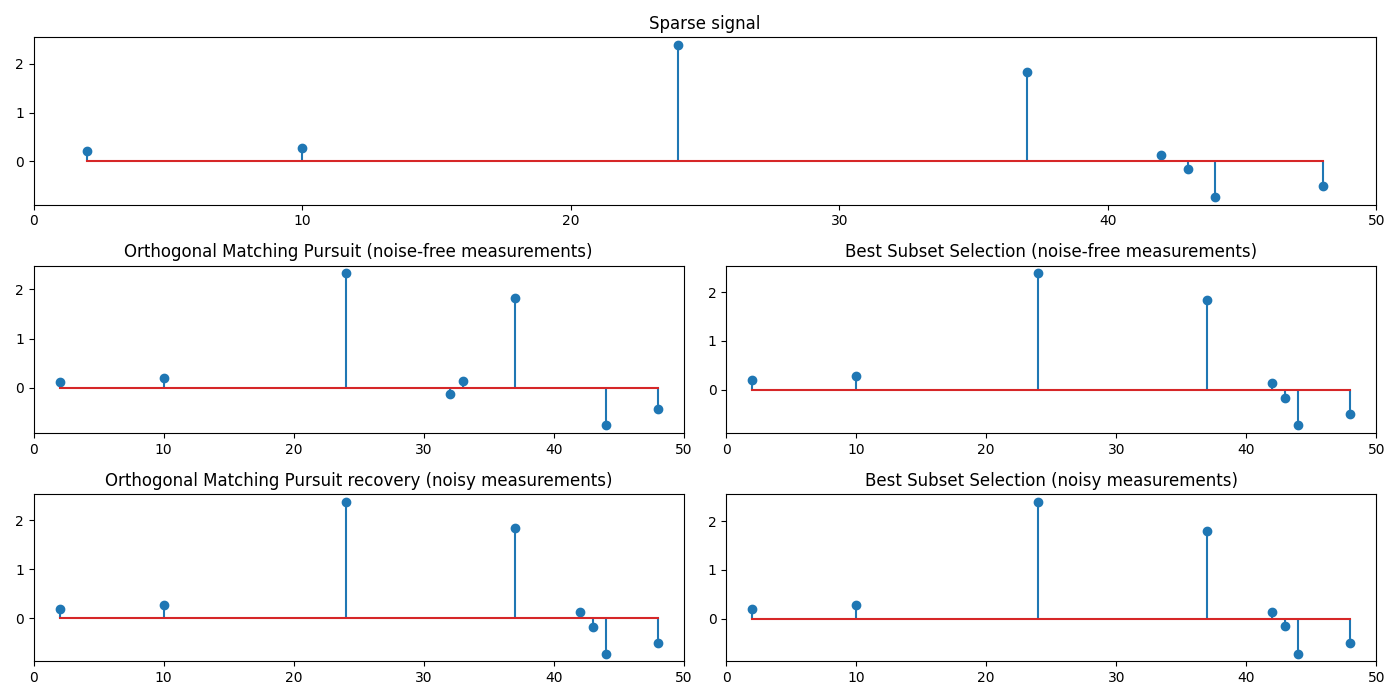Note
Go to the end to download the full example code
Recovering sparse signals#
In this example we compare the results obtained from BestSubsetSelection with those obtained using the OrthogonalMatchingPursuit regressor from scikit-learn.
Note that although using best subset selection tend to give more accurate results, OrthogonalMatchingPursuit scales much better to larger problems.
This example is adapted from the scikit-learn documentation: https://scikit-learn.org/stable/auto_examples/linear_model/plot_omp.html#sphx-glr-auto-examples-linear-model-plot-omp-py

Restricted license - for non-production use only - expires 2024-10-28
import matplotlib.pyplot as plt
import numpy as np
from sklearn.datasets import make_sparse_coded_signal
from sklearn.linear_model import OrthogonalMatchingPursuit
from sparselm.model import BestSubsetSelection
n_components, n_features = 50, 20
n_nonzero_coefs = 8
# generate the data
y, X, w = make_sparse_coded_signal(
n_samples=1,
n_components=n_components,
n_features=n_features,
n_nonzero_coefs=n_nonzero_coefs,
random_state=0,
)
X = X.T
(idx,) = w.nonzero()
# distort the clean signal
y_noisy = y + 0.005 * np.random.randn(len(y))
# plot the sparse signal
plt.figure(figsize=(14, 7))
plt.subplot(3, 2, (1, 2))
plt.xlim(0, n_components)
plt.title("Sparse signal")
plt.stem(idx, w[idx])
# plot the noise-free reconstruction
omp = OrthogonalMatchingPursuit(n_nonzero_coefs=n_nonzero_coefs)
omp.fit(X, y)
coef = omp.coef_
(idx_r,) = coef.nonzero()
plt.subplot(3, 2, 3)
plt.xlim(0, n_components)
plt.title("Orthogonal Matching Pursuit (noise-free measurements)")
plt.stem(idx_r, coef[idx_r])
bss = BestSubsetSelection(
sparse_bound=n_nonzero_coefs, solver="GUROBI", solver_options={"Threads": 8}
)
bss.fit(X, y)
coef = bss.coef_
(idx_r,) = coef.nonzero()
plt.subplot(3, 2, 4)
plt.xlim(0, n_components)
plt.title("Best Subset Selection (noise-free measurements)")
plt.stem(idx_r, coef[idx_r])
# plot the noisy reconstruction
omp.fit(X, y_noisy)
coef = omp.coef_
(idx_r,) = coef.nonzero()
plt.subplot(3, 2, 5)
plt.xlim(0, n_components)
plt.title("Orthogonal Matching Pursuit recovery (noisy measurements)")
plt.stem(idx_r, coef[idx_r])
bss.fit(X, y_noisy)
coef = bss.coef_
(idx_r,) = coef.nonzero()
plt.subplot(3, 2, 6)
plt.xlim(0, n_components)
plt.title("Best Subset Selection (noisy measurements)")
plt.stem(idx_r, coef[idx_r])
plt.tight_layout()
plt.show()
Total running time of the script: ( 0 minutes 43.349 seconds)